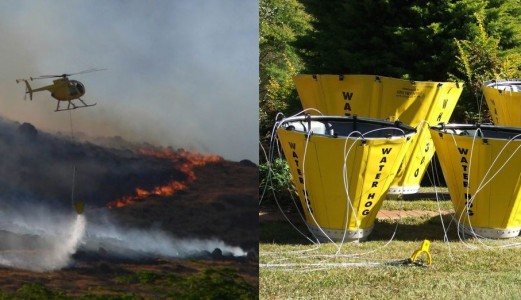Portable motor pumps are essential tools for wildland fire management and extinction. What follows is a decalogue of usage situations and the maneuvers that can be done to get the most out of this equipment.
Fire behavior (the spread scenario; in other words, the layer of vegetation affected) is one of the factors to be kept in mind when deciding upon the resources to be used and attack plan. The first thing you have to figure out is where the fire is going.
Surface fire
Surface fires can be of varying intensity: from low (the combustible material would mainly be herbaceous vegetation and undergrowth; fallen leaves, dead leaves, fallen branches, etc.), to medium (affecting scrub) to high (trees).
Where do they occur?
Surface fires can happen in very different places from pasturelands to shrublands and even pinewood forests.
Fighting maneuvers with motor pumps for low-intensity surface fires
A parallel configuration
Two or more motor pumps are connected in parallel when their flows converge into one. The resulting flow is the sum of all the individual flows. There is no increase in pressure, but there is an increase in flow.
What do you need?
Main elements: portable fire pump BH1, portable fire pump BP4, wildland fire hoses, a fire hose nozzle, pump fuel tank, fuel line complete for pump fuel tank and foot valve.

Fighting maneuvers with motor pumps for medium-intensity surface fires
A series configuration
A series configuration: two or more motor pumps are connected in a series when the resulting flow of one is fully delivered to the next. This type of configuration makes it possible to have higher pumping heights than would otherwise be achieved with an individual motor pump. In other words, the pressure is increased.
What do you need?
Main elements: portable fire pump BH1, portable fire pump BP4, wildland fire hoses, a fire hose nozzle, pump fuel tank, fuel line complete for pump fuel tank and foot valve.
High-intensity surface fires
When a surface fire reaches the tree tops, several things can happen.
- Torching or crowning: the fire jumps from the surface to the tree tops, but only in an isolated manner affecting only a few trees.
- Passive crown fire: fire that spreads in the canopy close to the surface which is dependent on the surface fire; if the surface fire is extinguished, the crown fire stops.
- Active crown fire: fire that spreads along the tree tops independently of the surface fire. It’s often driven by winds higher than 30 km/h. This type of fire can only be attacked indirectly.
In any of these scenarios, the intensity of the fire will prevent direct attack with a water line because the height of the flame will be greater than the extinguishing capacity (a direct attack with a water line is considered non-feasible from the ground when the flame height is more than 3 meters; there must be 5 meters from the air to maneuver from the ground).
Underground fires
Underground fires spread below the surface, consuming decomposing organic matter, roots and they can even reach rocky outcropping. They generally give off very little smoke and spread with incandescent combustion (very little or no flames) as there isn’t enough oxygen. These fires spread very slowly and are very difficult to put out because it’s difficult to get to the source of the fire. They burn for months.
Where do they occur?
Underground fires are often found in areas with rainy climates (more than 100,000 liters a year) where there is enough organic matter under the surface.
Fighting maneuvers with motor pumps
A parallel configuration.
You need a lot of pressure to reach the fire source and a large quantity of water. Therefore, you should use powerful motor pumps and large-capacity tanks. Injectors for reversed flows can also be helpful. In such a case, you would engage in a combined maneuver with a water line and manual tools.
What do you need?
Main elements: portable fire pump BH1, portable fire pump BP4, wildland fire hoses, a fire hose nozzle, pump fuel tank, fuel line complete for pump fuel tank, Heliskid and foot valve.
Other usage situations: entrapment in a wildland fire
When someone is trapped or a wildland fire begins to enter an urban forest environment, a motor pump configuration can be used to protect people, animals and property.
Self-protection maneuvers with motor pumps
A series configuration.
We have a water source far away from the assets that we need to protect. We will set a series configuration, the resulting flow converges into a self-protection nozzle which will spray the vegetation around whatever requires protection.
What do you need?
Main elements: portable fire pump BH1, portable fire pump BP4, wildland fire hoses, a fire hose nozzle, pump fuel tank, fuel line complete for pump fuel tank, foot valve and self-protection nozzle.









